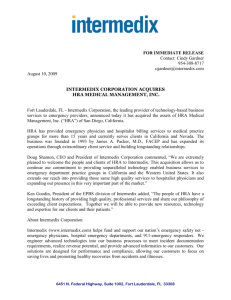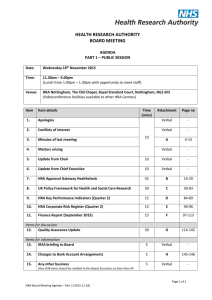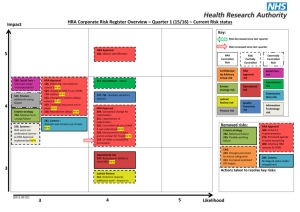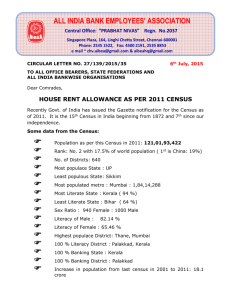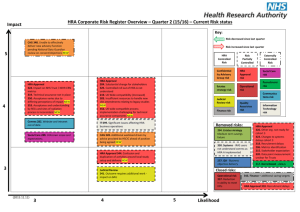Cover Letter for Draft Source Test Protocol, September 19, 2005
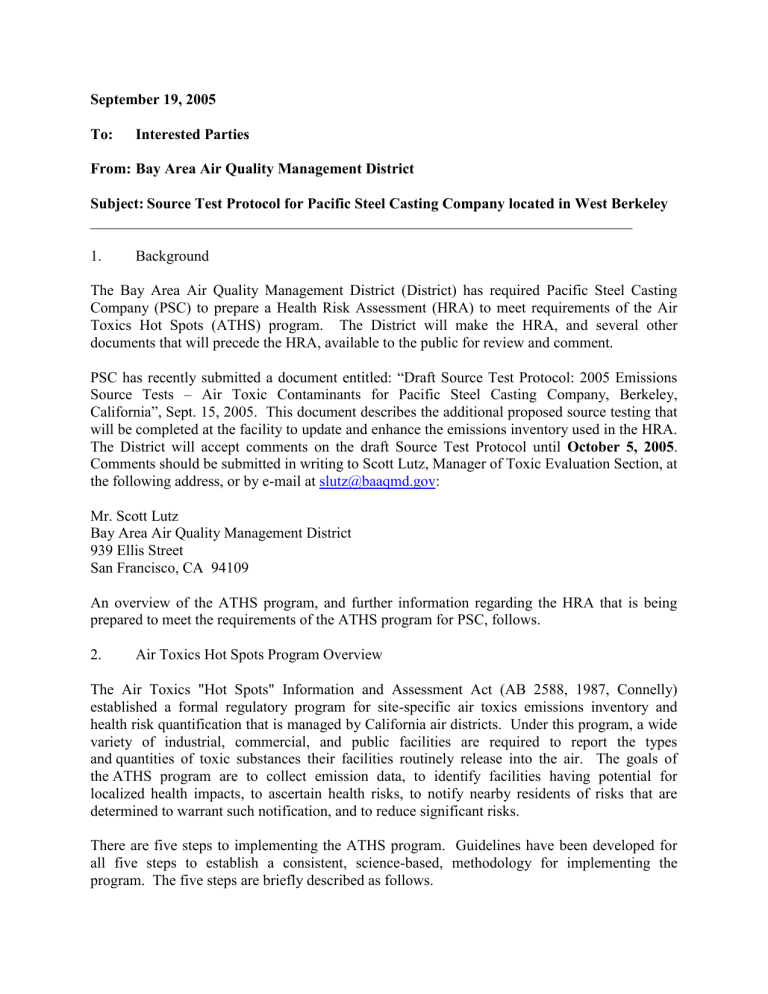
September 19, 2005
To: Interested Parties
From: Bay Area Air Quality Management District
Subject: Source Test Protocol for Pacific Steel Casting Company located in West Berkeley
________________________________________________________________________
1. Background
The Bay Area Air Quality Management District (District) has required Pacific Steel Casting
Company (PSC) to prepare a Health Risk Assessment (HRA) to meet requirements of the Air
Toxics Hot Spots (ATHS) program. The District will make the HRA, and several other documents that will precede the HRA, available to the public for review and comment.
PSC has recently submitted a document entitled: “Draft Source Test Protocol: 2005 Emissions
Source Tests – Air Toxic Contaminants for Pacific Steel Casting Company, Berkeley,
California”, Sept. 15, 2005. This document describes the additional proposed source testing that will be completed at the facility to update and enhance the emissions inventory used in the HRA.
The District will accept comments on the draft Source Test Protocol until October 5, 2005 .
Comments should be submitted in writing to Scott Lutz, Manager of Toxic Evaluation Section, at the following address, or by e-mail at slutz@baaqmd.gov
:
Mr. Scott Lutz
Bay Area Air Quality Management District
939 Ellis Street
San Francisco, CA 94109
An overview of the ATHS program, and further information regarding the HRA that is being prepared to meet the requirements of the ATHS program for PSC, follows.
2. Air Toxics Hot Spots Program Overview
The Air Toxics "Hot Spots" Information and Assessment Act (AB 2588, 1987, Connelly) established a formal regulatory program for site-specific air toxics emissions inventory and health risk quantification that is managed by California air districts. Under this program, a wide variety of industrial, commercial, and public facilities are required to report the types and quantities of toxic substances their facilities routinely release into the air. The goals of the ATHS program are to collect emission data, to identify facilities having potential for localized health impacts, to ascertain health risks, to notify nearby residents of risks that are determined to warrant such notification, and to reduce significant risks.
There are five steps to implementing the ATHS program. Guidelines have been developed for all five steps to establish a consistent, science-based, methodology for implementing the program. The five steps are briefly described as follows.
Air Toxics Emissions Inventory. Subject facilities are required to prepare and submit a comprehensive emissions inventory plan followed by a toxics emissions inventory report.
Each facility’s emissions inventory must be updated on a regular basis (e.g., to reflect changes in equipment, materials, and production levels at the facility).
Prioritization. Each facility is prioritized for potentially significant health impacts based on the quantity and toxicity of emissions, and the proximity of nearby residents and workers.
Health Risk Assessment. Facilities that are determined to be “high priority” are required to prepare and submit a comprehensive HRA. This is generally preceded by an HRA protocol that describes the HRA methodology including identification of key inputs and assumptions.
The HRA is reviewed by the air district and Cal/EPA’s Office of Environmental Health
Hazard Assessment (OEHHA).
Notification. If the health risks resulting from the facility’s emissions exceed action levels established by the air district, the facility is required to perform notification to all exposed persons regarding the results of the HRA.
Risk Reduction. If the health risks resulting from the facility’s emissions exceed significance levels established by the air district, the facility is required to conduct an airborne toxic risk reduction audit and develop a plan to implement measures that will reduce emissions from the facility to a level below the significance level within five years.
3. Pacific Steel Casting Company: Health Risk Assessment
Based on their most recently reported production levels, the District has re-prioritized the Pacific
Steel Casting facility under the ATHS program, and has determined that the requirement to prepare an HRA has now been triggered. Accordingly, the District has notified PSC of this requirement (in a letter dated April 11, 2005) and has established a schedule for submittal of the
HRA, and several preceding documents, as follows.
HRA protocol: Aug. 26, 2005
Source test plan and protocol: Sept. 15, 2005
Updated emissions inventory report: Dec. 30, 2005
HRA: Feb. 28, 2006
It should be noted that this schedule may be extended by the District, as allowed by statutory requirements, to provide additional time for completion of these documents if this is determined to be appropriate. Each document is being made available for public review and comment for a period of at least 15 days.
It should be noted that the HRA will not address odors associated with air emissions from PSC.
As a separate matter, in response to several violation notices issued this year related to odors, the
District has also required PSC to submit an odor control plan.
2
